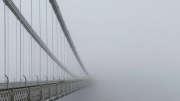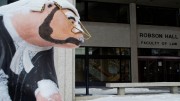Artist Frank Mikuska describes his teenage self as a “natural delinquent.” His older brother had been killed while working at an electricity company in Winnipeg, and his parents were adamant that Frank pursue a different career path. As a child, a nun had discovered his talent for drawing, and he was encouraged to attend art school. However, Mikuska is only able to see with his right eye. “If I look at you quickly, you seem like a cardboard cutout, I had to remove myself from being a sculptor,” he reflected. Against these odds, Mikuska went on to have a successful career as an artist and worked as a graphic designer for several decades at the Canadian Broadcasting Corporation. Mikuska experimented with painting techniques, creating powerful abstract works that demonstrate his remarkable handling of light and colour.
Now Mikuska has generously donated a large sample of artwork to Gallery One One One at the University of Manitoba. “The Frank Mikuska Donation” is currently on display and includes selected works by Mikuska, as well as those he collected from students and staff at the School of Art during the 1950s and ‘60s. Mikuska attended the Winnipeg School of Art when it was a private school housed in the Old Law Courts Building. In 1950, the Old Law Courts Building closed and the School of Art joined the University of Manitoba. Mikuska stayed on during this transformation, describing the atmosphere of the school as “dynamic and an exciting place to be.” Four graduates from the University of Iowa were brought in as staff: William McCloy, John Kacere, Richard Bowman and Robert Gadbois. As the faculty expanded, the influence of modern art took hold.
Standing in the gallery space, Mikuska reflected on his experience at the School of Art. “At the time the only school in the city was a private art school, and so when the art school came here, to have the weight of a university showed true — they brought in people who introduced us into modernism.” This introduction to modernism, as well as forms of abstraction, led Mikuska to experiment with new painting techniques, and he developed a system of painting using the unpredictable and volatile medium of printers ink’s to fill his canvases, as seen in the two large ink-on-gesso paintings on display.
In “Expansion,” completed in 1967-68, the majority of the canvas is filled with thin black ink; there is a small square in the top half of the canvas with waves of royal blue, white and yellow ink. Running through the right hand side of the canvas is a swirling form, the upper half has a thin layer of transparent yellow ink, allowing for the artist’s squiggling brush strokes to shine through. Below the section of pale yellow there is a section of bright red ink which has been integrated with the black, creating a rich sense of texture like it has been gone over with a piece of sand paper. It’s clear that Mikuska uses his medium of choice to its full potential, pushing the limits of color, light and texture.
The only art Mikuska ever saw as a boy was within the churches, government buildings or murals, influences which could account for the ethereal sense of light in “White Settler” (1965) or the tortured human form in “Primordium,” completed in 1959. The majority of his work is non-figural, although this painting contains an abstracted figure whose white ribs are clearly defined against the rough background of deep red and black ink. When he was explaining this work he casually said, “It is a carryover of a religious experience I had. At the time I was so much into church, so this is a crucifix in a way.” He paused, adding, “But I don’t know if I could say that. I could be reluctant to accept some kind of influence, I’m not sure.”
Also included in the exhibit are works by Bruce Head, Winston Leathers, Tony Tascona, Richard Bowman and Robert Gadbois. Thus, the donation of Mikuska’s own art is made even richer when placed alongside work from his contemporaries in the ‘50s and ‘60s, a time of great artistic experimentation. Mikuska pointed to the art in the gallery and said, “When you look at all of the art, it’s beautiful to see so much work and so many different ideas, and that’s the whole point — the ideas.” He said, “I think it’s worth looking at the past, and sometimes we look more at the classical things and we ride over this generation. It’s not that you want to convince [the students] that this is a better way of doing things, it’s just a way of saying, ‘there is reason for this kind of transition.’”




